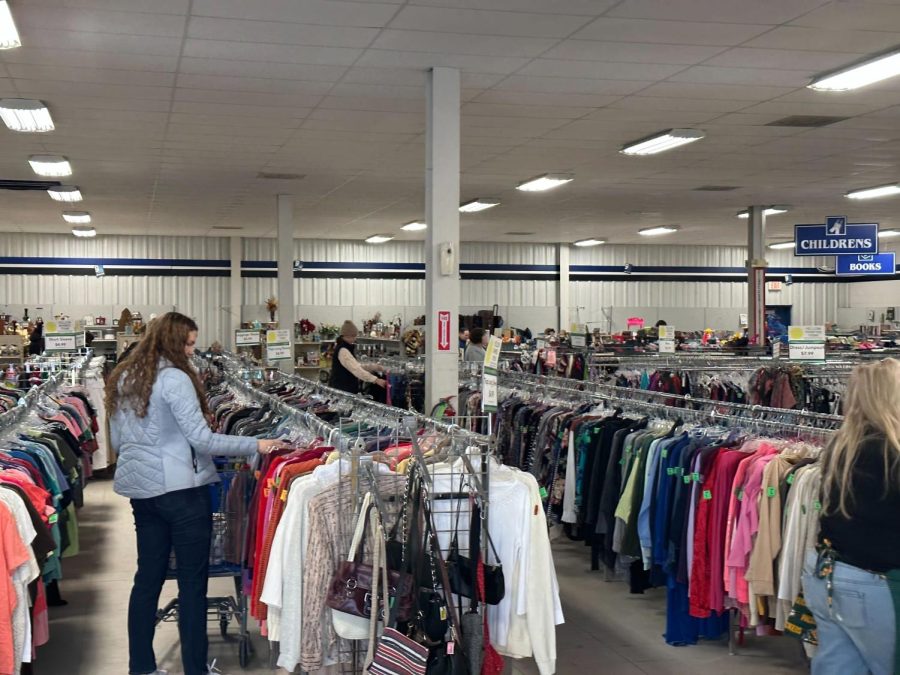Opinion — Why you should thrift more
TRASH OR TREASURE — Customers flip through racks of clothing at the Marquette Goodwill. Not only is thrift shopping an incredibly relaxing experience, but buying items second-hand is great for our environment.
February 1, 2023
On any given weekend, you will likely find me sifting through racks of clothing at a local thrift store.
Contrary to popular belief, my fondness for thrift shopping did not develop after listening to the 2012 smash hit “Thrift Shop” by Macklemore and Ryan Lewis. The song did, however, clarify precisely what a second-hand store was to my 11-year-old self — in addition to plaguing my obsessive brain with its catchy beat.
My addiction to thrifting began as soon as I was able to drive by myself. I remember watching videos on YouTube of the unique items — everything from vintage apparel to handheld trinkets — that people would score at thrift stores. I was eager to test my luck in the hunt and would set out to Goodwill and St. Vincent de Paul every other weekend with my friends.
It did not take long for us to realize that good finds were hard to come by. After clearing the local thrift stores of 80s band tees, crewnecks and shoulder bags, we would venture to thrifting locations in other parts of the Upper Peninsula.
While my friends and I were drowning in the competitiveness of finding the most desirable items, we failed to realize that we were reinforcing a great shopping habit that would benefit both ourselves and the environment in the future.
To start, thrift stores are a great way to save money. Everything from professional clothing to winter coats are sold at a reduced rate in thrift stores. I recently acquired a gorgeous mint green coat at a Marquette thrift store that appeared to be brand new and was of high quality. It was sold to me for just $12. In any retail clothing store, its price would have been around $50.
Just like my new coat, many items being donated to these stores are hardly used. I have even found some pieces with their original tags still on them, displaying retail prices and all.
Thrift stores are also incredibly convenient if you are looking for single-use items. During homecoming week in high school, I would immediately head to Goodwill to piece together my themed costumes for the week. I unapologetically do the same for my Halloween costumes to this day.
My countless trips to second-hand stores have also allowed me to develop a unique sense of style. If I were to describe the aesthetic of my thrift store hauls in three words, it would be “chic hiking mom.” Despite taking inspiration from her, my mom often pokes fun at a pair of jeans I purchased at a local thrift store that have no back pockets.
But guess what? I get complimented on them every time I wear them out.
Most importantly, thrift stores are great for the environment. By donating clothing, bags and shoes, you are reducing the number of items that will eventually end up in a landfill. Considering that most modern clothing is comprised of synthetic material, they will not completely decompose once they arrive at the junkyard — which leads to an increase in the emission of greenhouse gasses.
Instead, by donating these unwanted items they will be recycled in some way, shape or form.
The rise of the fast fashion industry — which exploits women and young children who work long and arduous hours for incredibly low wages — has caused the levels of carbon and chemical pollution in our environment to rise as well. According to Fashinnovation, the clothing being produced by fast fashion factories contains harmful pesticides in addition to being treated with dangerous chemicals and dyes.
And as if those facts were not alarming enough, mass clothing production heavily contributes to water waste. It is estimated that the cotton used to produce a single shirt requires 400 gallons of water, and a pair of blue jeans requires 1,800 gallons.
While the fast fashion industry will continue to foster an inhumane work environment and produce low-quality products that are harmful to both humans and the environment, you can do your part by opting to purchase a used good from a thrift store.
The existence of thrift stores is so beneficial to the environment, in fact, that the U.S. Bureau of Labor Statistics categorizes the position of thrift store salesclerks under “green jobs.”
When it comes down to it, thrifting is such a cathartic experience. While some find peace in sewing or reading, I like to take the edge off by getting lost in aisles of abandoned treasures. Even if you leave a store empty-handed, you will have found something so bizarre that you at least experience a good laugh before getting back in your vehicle.
Check out some of the North Wind staff’s favorite thrift store finds here:
Editor’s Note: The North Wind is committed to offering a free and open public forum of ideas, publishing a wide range of viewpoints to accurately represent the NMU student body. This is a staff column, written by an employee of the North Wind. As such, it expresses the personal opinions of the individual writer, and does not necessarily reflect the position of the North Wind Editorial Board.





























